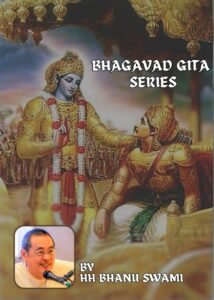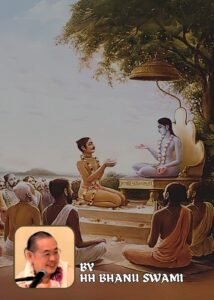Bhagavad Gītā 2 by HH Bhanu Swami Maharaj on Dec 12, 2024 @ ISKCON Japan
So this is Gītā jayanti we will have a little bit about Bhagavad Gita. So, Gītā Jayanti means the birth of the Gita, so the Gītā was spoken to Arjuna by Kṛṣṇa before the battlefield of Kurukshetra on this day. So, the work is in 18 chapters. Visvanatha Chakravarti divides this into 3 groups, 6 chapters, 6 chapters, 6 chapters.
So, first six chapters are prominently Karma Yoga. The last six chapters are prominently jñāna Yoga.
And the middle six chapters, from seven to twelve, are Bhakti Yoga. Of course, we will wonder, why don’t they have a nice order, Karma Yoga, jñāna Yoga, Aṣṭāṅga Yoga, then Bhakti Yoga at the end?
So, Visvanatha Chakravarti gives an example. If we have a jewel, we do not leave it out on the table. So, we stick it in a nice box. So, the box has a top and a bottom. So, the Bhagavad Gītā is like that. It has a top and a bottom, and in the middle we have the jewel, Bhakti Yoga. He also says that by being in the middle, it contacts Karma Yoga and jñāna Yoga. And thus, it gives life to both Karma Yoga and jñāna Yoga.
So, the first chapter is like introduction. It gives the circumstances under which Arjuna asks his questions. Circumstance is the battle of Kurukshetra.
So, the first verse that says Kurukshetra is Dharma kshetra. So, Dharma of course refers to the Pandavas. So, by mentioning Dharma kshetra, there is an indication the Pandavas will win the battle.
So, it’s a battle between Dharma and Adharma. And Adharma is represented by Dhṛtarāṣṭra and his son Duryodhana. So, that place Kurukshetra is glorified even in the Upaniṣads.
So, in the Jabala Upaniṣad it says that Kurukshetra is a place for sacrifice to the Devatas. It is the abode of Brahman, the supreme Brahman. So, this is Kurukshetra, Kshetra means a field. So, in the field we are growing a crop and we also get weeds. Sometimes the weeds are very tricky, they look just like the plant you are growing. So, the weeds will take away the nourishment of the plants, the plants won’t grow properly, so we have to pull them out. So, in this Kshetra, in this field, the Dharma is the real plant and the weeds are the Adharma.
So, this is a hint that Dhṛtarāṣṭra and his sons will be defeated. In the Bhagavatam and in first the Mahabharata, there is a whole story of the lineage of the Kurus and the Pandavas. And they trace their lineage back to Vaivasvata Manu. So, though it’s coming in a good lineage, somehow we get Adharma popping up. Same family, but whole bunch of demons.
So, in this diagram, we see the Pandavas are in one line here, and then we see Dhṛtarāṣṭra on this other line here. They coming from ultimately the same parentage.
So, in the scriptures, we have a little conflict. Different scriptures promote different ideas. So, we have Artha śāstra and Dharma śāstra. So, Artha śāstra is, let’s say, practical. So, for instance, it says here that who is the aggressor.
It gives all such examples. Who are the aggressors? One who sets fire, one who poisons, one who attacks with weapons, a thief, stealer of property, stealer of one’s wife. These are aggressors. And then you kill the aggressors… Aggressor – one who is attacking.
Ok. So, for Dharma śāstra… speaking about righteousness. What is the proper thing to do? So, the Dharma śāstras say, don’t have violence against any living entity. And Artha śāstra says, kill the enemies, the aggressors. So, it’s always confusing, which scripture are we going to follow? So, we have a hierarchy of scriptures which is stronger. Dharma is stronger than Artha.
If there are contradictory, opposite instructions, we take the Dharma śāstra as superior to the Arthashastra. So, a lot of Dharma śāstra is quoted in this chapter. You don’t follow Dharma, then you have a lot of problems.
We kill our relatives, that destroys the family, and then the rules of the family are destroyed, that means Dharma is destroyed. So, when Dharma is destroyed, Adharma increases. The women become contaminated, and then they start mixing up the varnas and then we have what’s called Varna Sankara, mixed castes.
So, Arjuna is saying, well, better that I sacrifice my own life. I won’t fight. I will just die.
I don’t want to kill. So, by doing so, I will atone for the sin of thinking of killing my relatives. So, in this way, Arjuna is confused. So, it describes how he was so confused that he threw down his bow and arrow. So, this is very disgraceful for a Kshatriya. And he was thinking, should I fight or not fight? Should I think of myself? Should I think of others? Should I think of society? Should I think of Dharma, or Svargaloka, or sin, or hellish existence? So, then chapter 2 begins, and then Arjuna, he’s confused, he goes to Kṛṣṇa and asks, what should I do? So, the best course of action will actually be defined upon what’s the best goal.
So, the Supreme Lord can define the goal, he doesn’t, no speculation. He knows what the real goal is.
Once we know what the goal is, then we can determine what’s the best action. Of course, problem with scripture is that we have many goals. And then we have many processes to get to different goals. However, all of these goals should actually lead to one goal. So, ultimately, goal is Prema. Not Svargaloka, not liberation.
So, all these different yogas are steps towards bhakti-yoga and Prema. So, Kṛṣṇa starts in the second chapter by giving explanation of the soul, ātmā. He also distinguishes the ātmā from the Supreme Lord. He gives a method for realizing ātmā. He also talks about Niṣkāma Karma Yoga and he recommends this is the best type of action for Arjuna.
And then he describes the characters of someone called Sthita-prajña, a person who has realized ātmā. So, Arjuna was qualified for knowledge. He had control of his senses and mind.
He was indifferent to the enjoyments of material life. He was very tolerant of the dualities of the material world. And he had deep faith in the words of Guru.
So, he was very qualified, and he was also say very intelligent, so therefore he approached Kṛṣṇa and said, “What is the best thing for me to do”? So, Arjuna says, I surrender unto you. You please instruct me. So, by doing this, Arjuna shows that we should accept a Guru.
So, not only Bhagavad Gītā says this, the Upaniṣads, the Sruti also talking about the surrender to Guru to get knowledge. So, Prabhupada often quotes these verses. tad-vijñānārthaṁ sa gurum evābhigacchet (Muṇḍaka Upaniṣad 1.2.12), You must approach a Guru to get knowledge.
Another quote is, Ācāryavān puruṣo veda, person who has an Acharya knows the Lord. If you have a Guru, you can know the Lord. So, whatever we attain, the goals of Artha and Dharma are not satisfactory.
So, Arjuna is not interested in kingdom, or going to Svargaloka, etc. So, fighting, of course, is a good activity for a Kshatriya by doing so, he goes to Svargaloka. But, Arjuna is not interested in that, so why should I fight?
So, Kṛṣṇa gives some very direct instructions. And so, Kṛṣṇa says, the wise men do not lament for the gross bodies, the subtle bodies, or the souls. So, the gross bodies are going to get destroyed anyway, so why should we lament? And, we shouldn’t lament for the subtle body, because it doesn’t get destroyed when the gross body is destroyed. We shouldn’t lament for the soul, the ātmā, because it has no birth, no existence, no increase, no transformation, decay, etc., It’s eternal.
So, the first important teaching is, we’re not the body, we’re the soul. Then, the second important teaching is, soul is different from the Lord. So, this is a very important distinction. And, we can use this to defeat the people who say that everyone becomes God.
Ok. So, he explains how the soul goes through this life, through different transformations of the body, when you die it goes into another body. So, when a person dies, he’s merely going into another body, so we should not lament. So, Kṛṣṇa advises Arjuna, we have to tolerate the fluctuations in this world, happiness and distress, hot and cold, etc. So, you tolerate and you perform Dharma, you fight.
By following Dharma, you become purified, and then you come to the level of Jñāna. So, once you’ve got the Jñāna, you can get liberation. So, Kṛṣṇa emphasizes you should not give up Dharma before you’re ready, prematurely.
You should become fixed in knowledge, then you can give up Dharma. So, once we get knowledge of ātmā, then we progress to knowledge of the Lord. So, Bhagavad Gītā teaches knowledge of ātmā, but it does not stop there. That’s the first step and this will lead to Bhakti.
Ok. So, Kṛṣṇa advises Arjuna, you should do Karma Yoga until you can be qualified for jñāna Yoga. So, what type of action should Arjuna do? He should follow Niṣkāma Karma Yoga.
We should try to do the actions of Karma Yoga, Varnashrama, etc., but we don’t have personal desires to get something out of it.
So, this is a good preparation for Jñāna, understanding ātmā. So, this… following Niṣkāma Karma Yoga is the advice that Kṛṣṇa gives to Arjuna.
By following this process, you get saved from birth and death. If you do not do everything completely, no loss. And if we make a mistake, also there is no problem. So, therefore the Vaishyas follow the path of Niṣkāma Karma Yoga.
If we do Sākama Karma Yoga, we have to do everything perfectly, then we get some results.
Any defect will give us opposite results, therefore we should do Niṣkāma Karma Yoga and in this way we can become steady in Jñāna. So when we do Nishikama Karma Yoga, we’re actually becoming fixed on Ātmā.
Ok. So, in practicing this, we should become fixed on the Ātmā. So other people not so fixed then they have all sorts of desires which is said to be many branches. So this is… Niṣkāma Karma Yoga is easier process. So you are suitable to do the karmas, your job etc., all the work of Svadharma, but don’t try to desire the results.
So, by doing actions of Karma Yoga with no personal desire, we get steadiness in Jñāna.
So, if we perform this Niṣkāma Karma Yoga, we don’t cause any bad results. So, we perform our actions with no personal desire and we get the best results. So Kṛṣṇa has been talking about doing Niṣkāma karma yoga qualifies you for Jñāna, so then he talks about being fixed, the person who is fixed in ātmā. So, he attains this state by lack of desire. He should not have desire then he can realize ātmā, he can fix in ātmā. So, the example is given of the turtle, who withdraws his limbs inside his body or shell.
So, the person should withdraw his senses from sense objects. And when he is so situated, he is called Prajna, very wise. So, though this chapter is emphasizing Niṣkāma Karma Yoga, then Kṛṣṇa also begins at the end of this chapter to mention Supreme Lord.
So, if we have some bhakti, we have some devotion to the Lord, becomes easier to become steady in ātmā. This chapter also describes how a person falls into maya. He meditates on the sense objects, becomes attached, then from the attachment comes desire, and if the desire is not fulfilled, he gets anger. From anger, there’s loss of discrimination. We can’t distinguish what’s right and wrong.
From the lack of discrimination, we get lack of control of the senses. And from that lack of control of the senses, we lose determination to realize ātmā. So, we have to control the senses and the mind. If we want to conquer the mind and the senses, we have to worship the Lord. So, the example is given about the sthita prajna is awake and when other people are sleeping. So, what this means is, one who is situated or sees ātmā has no taste for other objects.
So, he describes the sthita prajna like ocean. So, many rivers go into the ocean, but the ocean always stays the same. So, the sthita prajna sees the world, they act in the world, but he always remains peaceful.
So, he lives in the world, but he’s not affected by anything in the world. How is that possible? He’s fixed in ātmā. So, if we can do this nicely and fix our mind on the Lord, even at death, then we can attain the Lord.
So, ultimately the state of being sthita prajna being fixed in ātmā is actually caused by worshipping the Lord. Okay, that’s the end of chapter 2. Okay, we end there, I guess.
Q & A
1)Chapter 3 is also Karma Yoga. Karma Yoga, yeah. That’s normal Karma Yoga.
HH Bhanu Swami Maharaj: Yeah, well, both. He talks about enjoying and everything, going to Svarga Loka, etc.
Yeah, chapter 3.
Devotee: And chapter 5 also Karma Yoga, but actually…
HH Bhanu Swami Maharaj: A little bit, yeah. Actually, it’s a mixture of many things also, jñāna is in there. And 6 is a little bit of everything, but then we have to get Aṣṭāṅga Yoga in there. 4 is also glorification of jñāna Yoga.
2) Realizing the ātmā by jñāna and realizing the ātmā by Bhakti Yoga… So, what’s the difference?
So, you are asking what’s the difference between realising by jñāna or Bhakti, the ātmā. To practice jñāna Yoga by itself, to realize ātmā, is difficult. And to realize ātmā, we also need some Bhakti, some mercy of the Lord. So, the real intelligent Jnani will also have some Bhakti. And one who does jñāna and rejects Bhakti, he cannot get liberation.
One who does pure Bhakti, not doing other processes, he surpasses liberation. He’s not interested in liberation because it’s unfavourable for Bhakti. He’s interested in serving the Lord eternally. To do that, the Lord has the devotee surpass liberation, jñāna Yoga, and get to the spiritual world.
3) Who all heard the Bhagavad Gītā directly?
Well, besides Arjuna, well, Sanjaya, obviously, he’s telling it to Dhritarashtra, no?
Devotee: Bhishmadev also?
HH Bhanu Swami Maharaj: Hmm, that is not mentioned.
Devotee: Did only Sañjaya and Arjuna hear Bhagavad Gita. Nobody else hear it?
HH Bhanu Swami Maharaj: It doesn’t say, I would suppose that if they were devotees they can hear it, if they were not devotees they wouldn’t hear it. [Laughing]
4) Kṛṣṇa said that I spoke Bhagavad Gītā, the same Bhagavad Gītā to Sun god. Did He speak to Sun god about Varnashrama?
It is not specific he imparts knowledge, same knowledge in one sense. And Bhagavad Gītā has all the knowledge, Karma yoga, jñāna yoga Aṣṭāṅga yoga and Bhakti yoga. So he previously taught these things, now he is teaching this again.
Hare Krishna
Devotees: Srimad Bhagavad Gita Ki.. Jai ! Srila Prabhupad Ki.. Jai !! HH Bhanu Swami Maharaj Ki.. Jai !!


